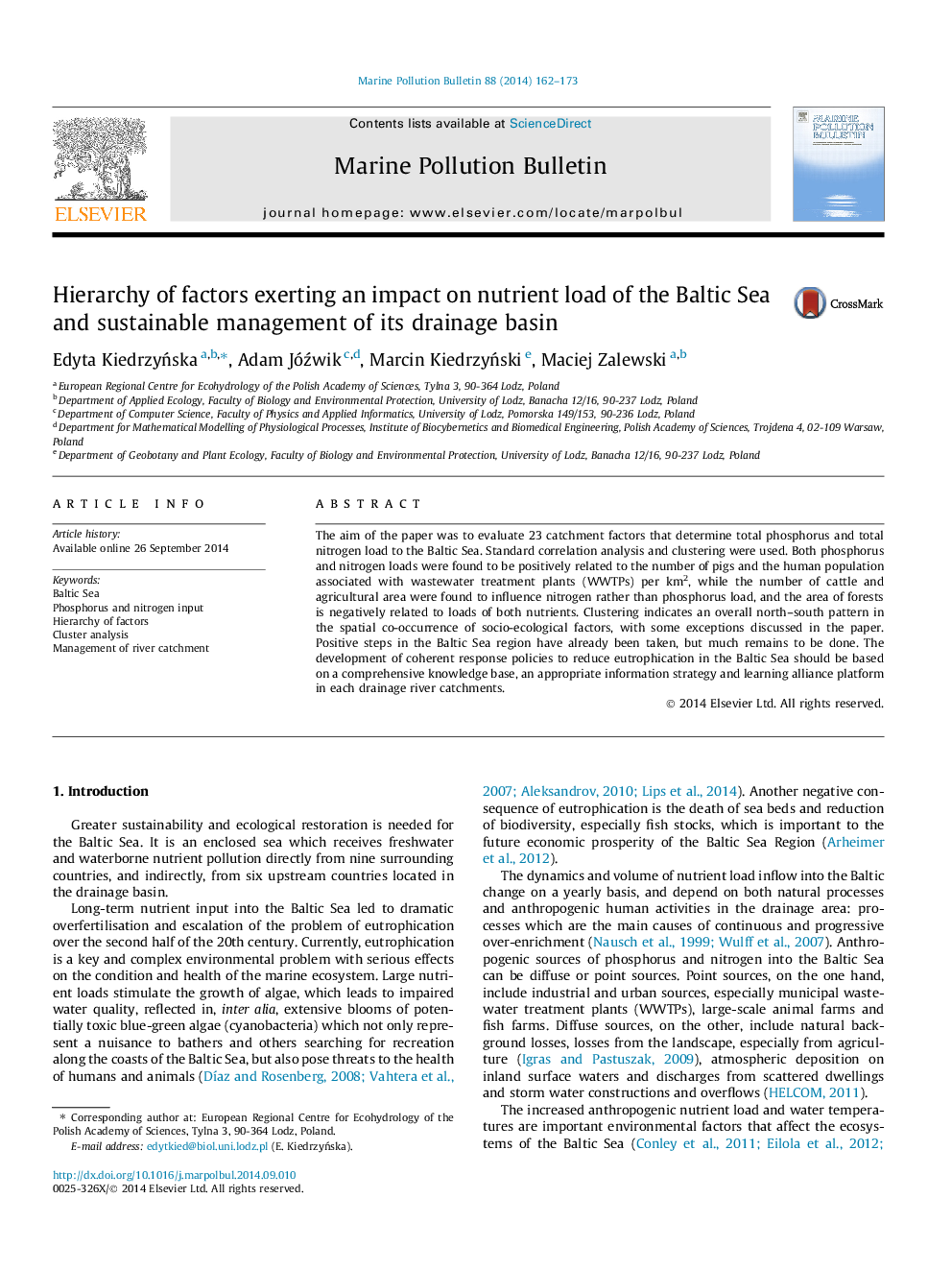| کد مقاله | کد نشریه | سال انتشار | مقاله انگلیسی | نسخه تمام متن |
|---|---|---|---|---|
| 6358269 | 1622740 | 2014 | 12 صفحه PDF | دانلود رایگان |
عنوان انگلیسی مقاله ISI
Hierarchy of factors exerting an impact on nutrient load of the Baltic Sea and sustainable management of its drainage basin
ترجمه فارسی عنوان
سلسله مراتبی عوامل موثر بر بار مواد مغذی دریای بالتیک و مدیریت پایدار حوضه زهکشی آن
دانلود مقاله + سفارش ترجمه
دانلود مقاله ISI انگلیسی
رایگان برای ایرانیان
کلمات کلیدی
دریای بالتیک، ورودی فسفر و نیتروژن، سلسله مراتب عوامل، آنالیز خوشه ای، مدیریت حوضه رودخانه،
ترجمه چکیده
هدف از این مقاله ارزیابی 23 فاکتور غرقابی است که فسفر کل و کل نیتروژن کل را به دریای بالتیک تعیین می کند. تجزیه و تحلیل همبستگی استاندارد و خوشه بندی استفاده شده است. هر دو فسفر و بارهای نیتروژن به طور مثبت با تعداد خوک ها و جمعیت انسانی مرتبط با گیاهان تصفیه فاضلاب (کیلومتر مربع) ارتباط داشتند، در حالی که تعداد گاو و مناطق کشاورزی به جای بار فسفر تاثیر نیتروژن داشت و مساحت جنگل با بارهای هر دو مواد مغذی منفی است. خوشه بندی یک الگوی کلی شمالی-جنوبی را در فضایی فضایی عوامل اجتماعی-محیطی نشان می دهد، با برخی از استثنائات مورد بحث در این مقاله. گام های مثبت در منطقه دریای بالتیک قبلا گرفته شده است اما هنوز هم باید انجام شود. توسعه سیاست های انطباق پاسخ برای کاهش ائتروفیکی در دریای بالتیک باید بر مبنای پایه ی جامع دانش، استراتژی اطلاعات مناسب و یادگیری یک پلت فرم یکپارچه در هر حوضه رودخانه زهکشی باشد.
موضوعات مرتبط
مهندسی و علوم پایه
علوم زمین و سیارات
اقیانوس شناسی
چکیده انگلیسی
The aim of the paper was to evaluate 23 catchment factors that determine total phosphorus and total nitrogen load to the Baltic Sea. Standard correlation analysis and clustering were used. Both phosphorus and nitrogen loads were found to be positively related to the number of pigs and the human population associated with wastewater treatment plants (WWTPs) per km2, while the number of cattle and agricultural area were found to influence nitrogen rather than phosphorus load, and the area of forests is negatively related to loads of both nutrients. Clustering indicates an overall north-south pattern in the spatial co-occurrence of socio-ecological factors, with some exceptions discussed in the paper. Positive steps in the Baltic Sea region have already been taken, but much remains to be done. The development of coherent response policies to reduce eutrophication in the Baltic Sea should be based on a comprehensive knowledge base, an appropriate information strategy and learning alliance platform in each drainage river catchments.
ناشر
Database: Elsevier - ScienceDirect (ساینس دایرکت)
Journal: Marine Pollution Bulletin - Volume 88, Issues 1â2, 15 November 2014, Pages 162-173
Journal: Marine Pollution Bulletin - Volume 88, Issues 1â2, 15 November 2014, Pages 162-173
نویسندگان
Edyta KiedrzyÅska, Adam Jóźwik, Marcin KiedrzyÅski, Maciej Zalewski,
